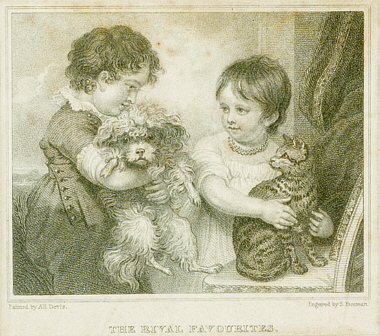'Feathers, Fins and Fur' Spotlights Early Maryland
Pets

An undated illustration from 'Cats
and Their Ways: A Most Extensive and Amusing Collection of
Engravings,' a holding of the John Work Garrett Library of
The Johns Hopkins University.
|
By Heather Egan Stalfort
Historic
Houses
Cats and dogs are reigning at Homewood Museum,
where a winter focus exhibition titled Feathers, Fins and
Fur: The Pet in Early Maryland has just opened. Organized
in partnership with the Maryland Society for the Prevention
of Cruelty to Animals, it continues through March 31.
The exhibition is the culmination of a fall
undergraduate seminar called Introduction to Material
Culture: The Pet in Early America, co-taught in Homewood's
original wine cellar by Catherine Rogers Arthur, the
museum's curator, and Stuart "Bill" Leslie, a professor in
the Krieger School's Department of History of Science and
Technology.
The seminar was part of Johns Hopkins' newly created
Museums and Society Program, an interdisciplinary course of
study leading to a minor degree that offers undergraduates
significant opportunities to establish meaningful
connections with local and regional museums.
Drawing on correspondence, probate inventories,
newspaper ads, journals and a rich array of visual
materials, Feathers, Fins and Fur explores views of the
pets and livestock that were part of the scenery of early
Maryland and especially of Homewood, the 1801 country house
of the Carroll family.
The students assisted in organizing and curating the
show, in addition to the more practical aspects of
exhibition production. "It's not just about research," said
Lauren Strelec, a senior majoring in the history of science
and technology, during the fall semester. "We do that, but
we are also hunting down artifacts, coordinating displays
and consulting with designers to create a catalog."
From engraved silver to spike-studded leather collars,
this collaborative exhibition offers a unique opportunity
to study the practices of pet-keeping in early Maryland,
exploring not only how the often complicated relationships
between animals and their owners were defined and observed
but how the early-19th-century understanding of animal
companionship compares to that of today. "We're looking at
a popular, contemporary topic through the eyes of early
Americans," observed Sandra Lackovic, a senior majoring in
behavioral biology who plans to attend veterinary school.
Divided into several sections, the exhibition focuses
on specific kinds of pets — including cats, dogs,
birds, fish, horses and rodents — and related themes
such as early veterinary practices, wild animal
domestication, the affiliation between children and pets,
and animal idioms. A variety of early dog collars, recipes
for pet food, cages for small animals and fishbowls also
are on display.
Related activities (see below) will augment the
exhibition, on view to visitors during regularly scheduled
tours of the museum, offered every half hour from 11 a.m.
to 4 p.m. Tuesday to Friday, and noon to 4 p.m. Saturday
and Sunday (the last tour departs at 3:30 p.m.). Admission
to the exhibition and related programs is free with regular
museum admission: $6 adults, $5 seniors, $3 students and
children 6 and up, free for museum members and JHU
affiliates with ID.
Free museum admission also will be granted to any
visitor who brings in an item from the Maryland SPCA's
Animal Wish List, including pet food, toys and cleaning
products, for the duration of the exhibition. The list is
available online at www.mdspca.org or by calling Homewood
House at 410-516-0341. For more information, call
410-516-0341 or go to www.jhu.edu/historichouses.
Significant funding for the exhibition was provided by
Anne Merrick Pinkard, whose generous contribution to
Homewood House also makes it possible for the undergraduate
seminar in material culture to be repeated in successive
years, with different topics contributing to an ongoing
understanding of early-19th-century life at Homewood.

Related Events
Find a Friend for Life
Meet adoptable pets from the Maryland SPCA in
Homewood's wine cellar. Noon to 2 p.m. on Jan. 24 and every
other Saturday through March 31. Free with museum
admission.
When Animals Could Talk
Charles Camp, author, MICA art history faculty member
and former Maryland state folklorist, looks at animals in
folktale traditions. Noon on Wednesday, Jan. 24. Free with
museum admission.
 GO TO JANUARY 8,
2007
TABLE OF CONTENTS.
GO TO JANUARY 8,
2007
TABLE OF CONTENTS.
 GO TO THE GAZETTE
FRONT PAGE.
GO TO THE GAZETTE
FRONT PAGE.
|